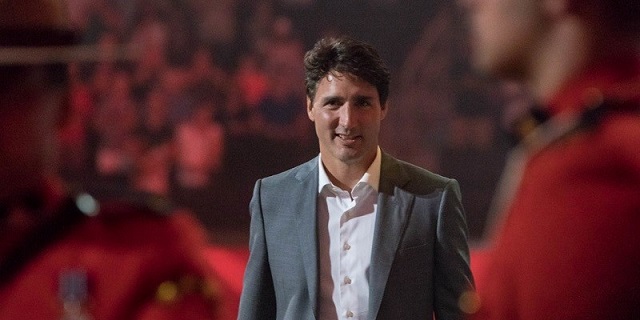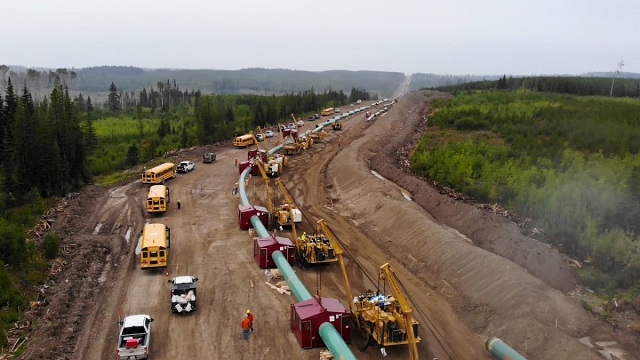Business
Federal government should stay in its lane

From the Fraser Institute
By Jason Clemens and Jake Fuss
There’s been more talk this year than normal about the need for governments, particularly Ottawa, to “stay in their own lane.” But what does this actually mean when it comes to the practical taxing, spending and regulating done by provincial and federal governments?
The rules of the road, so to speak, are laid out in sections 91 and 92 of the Canadian Constitution. As noted economist Jack Mintz recently explained, the federal government was allocated responsibility for areas of national priority such as defence and foreign relations, criminal law, and national industries such as transportation, communication and financial institutions. The provinces, on the other hand, were allotted responsibilities deemed to be closer to the people such as health care, education, social services and municipalities.
Simply put, the principle of staying in one’s lane means the federal and provincial governments respect one another’s areas of responsibility and work collaboratively when there are joint interests and/or overlapping responsibilities such as environmental issues.
The experience of the mid-1990s through to roughly 2015 shows the tangible benefits of having each level of government focus on their areas of responsibility. Recall that the Liberal Chrétien government fundamentally removed itself from several areas of provincial jurisdiction, particularly welfare and social services, in its historic 1995 budget.
But the election of the Trudeau government in 2015 represented a marked change in approach. The tax and spending policies of the Trudeau government, which broke a 20-year consensus, favoured ever-increasing spending, higher taxes and much higher levels of borrowing. Federal spending (excluding interest payments on debt) has increased from $273.6 billion in 2015-16 when Trudeau first took office to an expected $483.6 billion this year, an increase of 76.7 per cent.
Federal taxes on most Canadians, including the middle class, have also increased despite the Trudeau government promising lower taxes. And despite the tax increases, borrowing has also increased. Consequently, the national debt has ballooned from $1.1 trillion when Trudeau took office to an estimated $2.1 trillion this year.
Despite these massive spending increases, there are serious questions about core areas of federal responsibility. Consider, for example, the major problems with Canada’s defence spending.
Canada has been called out by both NATO officials and our counterparts within NATO for failing to meet our commitments. As a NATO country, Canada is committed to spend 2 per cent of the value of our economy (GDP) annually on defence. The latest estimate is that Canada will spend 1.4 per cent of GDP on defence and we’re the only country without a plan to reach the target by 2030. The Parliamentary Budget Officer recently estimated that to reach our NATO commitment, defence spending would have to increase by $21.3 billion in 2029-30, which given the state of federal finances would entail much higher borrowing and/or higher taxes.
So, while the Trudeau government has increased federal spending markedly, it has not spent those funds on core areas of federal responsibility. Instead, Trudeau’s Ottawa has increasingly involved itself in provincial areas of responsibility. Consider three new national initiatives that are all squarely provincial areas of responsibility: pharmacare, $10-a-day daycare and dental care.
And the amounts involved in these programs are not incidental. In Budget 2021, the Trudeau government announced $27.2 billion over five years for the new $10-a-day daycare initiative, Budget 2023 committed $13.0 billion for the dental benefit over five years, and Budget 2024 included a first step towards national pharmacare with spending of $1.5 billion over five years to cover most contraceptives and some diabetes medications.
So, while the Trudeau government has deprioritized core areas of federal responsibility such as defence, it has increasingly intruded on areas of provincial responsibility.
Canada works best when provincial and federal governments recognize and adhere to their roles within Confederation as was more the norm for more than two decades. The Trudeau government’s intrusion into provincial jurisdiction has increased tensions with the provinces, likely created unsustainable new programs that will ultimately put enormous financial pressure on the provinces, and led to a less well-functioning federal government. Staying in one’s lane makes sense for both driving and political governance.
Authors:
Business
Budget 2025: Ottawa Fakes a Pivot and Still Spends Like Trudeau

It finally happened. Canada received a federal budget earlier this month, after more than a year without one. It’s far from a budget that’s great. It’s far from what many expected and distant from what the country needs. But it still passed.
With the budget vote drama now behind us, there may be space for some general observations beyond the details of the concerning deficits and debt. What kind of budget did Canada get?
Haultain’s Substack is a reader-supported publication.
To receive new posts and support our work, please consider becoming a free or paid subscriber.
Try it out.
For a government that built its political identity on social-program expansion and moralized spending, Budget 2025 arrives wearing borrowed clothing. It speaks in the language of productivity, infrastructure, and capital formation, the diction of grown-up economics, yet keeps the full spending reflex of the Trudeau era. The result feels like a cabinet trying to change its fiscal costume without changing the character inside it. Time will tell, to be fair, but it feels like more rhetoric, and we have seen this same rhetoric before lead to nothing. So, I remain skeptical of what they say and how they say it.
The government insists it has found a new path, one where public investment leads private growth. That sounds bold. However, it is more a rebranding than a reform. It is a shift in vocabulary, not in discipline.
A comparison with past eras makes this clear.
Jean Chrétien and Paul Martin did not flirt with restraint; they executed it. Their budgets were cut deeply, restored credibility, and revived Canada’s fiscal health when it was most needed. The Chrétien years were unsentimental. Political capital was spent so financial capital could return. Ottawa shrank so the country could grow. Budget 2025 tries to invoke their spirit but not their actions. Nothing in this plan resembles the structural surgery of the mid 1990s.
Stephen Harper, by contrast, treated balanced budgets as policy and principle. Even during the global financial crisis, his government used stimulus as a bridge, not a way of life. It cut taxes widely and consistently, limited public service growth, and placed the long-term burden on restraint rather than rhetoric. Budget 2025 nods toward Harper’s focus on productivity and capital assets, yet it rejects the tax relief and spending controls that made his budgets coherent.
Then there is Justin Trudeau, the high tide of redistribution, vacuous identity politics, and deficit-as-virtue posturing. Ottawa expanded into an ideological planner for everything, including housing, climate, childcare, inclusion portfolios, and every new identity category. Much of that ideological scaffolding consisted of mere words, weakening the principle of equality under the law and encouraging the government to referee culture rather than administer policy.
Budget 2025 is the first hint of retreat from that style. The identity program fireworks are dimmer, though they have not disappeared. The social policy boosterism is quieter. Perhaps fiscal gravity has begun to whisper in the prime minister’s ear.
However, one cannot confuse tone for transformation.
Spending is still vast. Deficits grew. The new fiscal anchor, balancing only the operating budget, is weaker than the one it replaced. The budget relies on the hopeful assumption that Ottawa’s capital spending will attract private investment on a scale that economists politely describe as ambitious.
The housing file illustrates the contradiction. The budget announces new funding for the construction of purpose-built rentals and a larger federal role in modular and subsidized housing builds. These are presented as productivity measures, yet they continue the Trudeau-era instinct to centralize housing policy rather than fix the levers that matter. Permitting delays, zoning rigidity, municipal approvals, and labour shortages continue to slow actual construction. Ottawa spends, but the foundations still cure at the same pace.
Defence spending tells the same story. Budget 2025 offers incremental funding and some procurement gestures, but it avoids the core problem: Canada’s procurement system is broken. Delays stretch across decades. Projects become obsolete before contracts are signed. The system cannot buy a ship, an aircraft, or an armoured vehicle without cost overruns and missed timelines. Spending more through this machinery will waste time and money. It adds motion, not capability.
Most importantly, the structural problems remain untouched: no regulatory reform for major projects, no tax competitiveness agenda, no strategy for shrinking a federal bureaucracy that has grown faster than the economy it governs. Ottawa presides over a low-productivity country but insists that a new accounting framework will solve what decades of overregulation and policy clutter have created. More bluster.
To receive new posts and support our work, please consider becoming a free or paid subscriber.
From an Alberta vantage, the pivot is welcome but inadequate. The economy that pays for Confederation, energy, mining, agriculture, and transportation receives more rhetorical respect in Budget 2025, yet the same regulatory thicket that blocks pipelines and mines remains intact. The government praises capital formation but still undermines the key sectors that generate it.
Budget 2025 tries to walk like Chrétien and talk like Harper while spending like Trudeau. That is not a transformation; it is a costume change. The country needed a budget that prioritized growth rooted in tangible assets and real productivity. What it got instead is a rhetorical turn without the courage to cut, streamline, or reform.
Canada does not require a new budgeting vocabulary. It requires a government willing to govern in the best interest of the country.
Haultain’s Substack is a reader-supported publication.
Help us bring you more quality research and commentary.
Business
Large-scale energy investments remain a pipe dream

I view the recent announcements by the Government of Canada as window dressing, and not addressing the fundamental issue which is that projects are drowning in bureaucratic red tape and regulatory overburden. We don’t need them picking winners and losers, a fool’s errand in my opinion, but rather make it easier to do business within Canada and stop the hemorrhaging of Foreign Direct Investment from this country.
Thanks for reading William’s Substack!
Subscribe for free to receive new posts and support my work.
Changes are afoot—reportedly, carve-outs and tweaks to federal regulations that would help attract investment in a new oil pipeline from Alberta. But any private proponent to come out of this deal will presumably be handpicked to advance through the narrow Bill C-5 window, aided by one-off fixes and exemptions.
That approach can only move us so far. It doesn’t address the underlying problem.
Anyone in the investment world will tell you a patchwork of adjustments is nowhere near enough to unlock the large-scale energy investment this country needs. And from that investor’s perspective, the horizon stretches far beyond a single political cycle. Even if this government promises clarity today in the much-anticipated memorandum of understanding (MOU), who knows whether it will be around by the time any major proposal actually moves forward.
With all of the talk of “nation-building” projects, I have often been asked what my thoughts are about what we must see from the federal government.
The energy sector is the file the feds have to get right. It is by far the largest component of Canadian exports, with oil accounting for $147 billion in 2024 (20 percent of all exports), and energy as a whole accounting for $227 billion of exports (30 percent of all exports).
Furthermore, we are home to some of the largest resource reserves in the world, including oil (third-largest in proven reserves) and natural gas (ninth-largest). Canada needs to wholeheartedly embrace that. Natural resource exceptionalism is exactly what Canada is, and we should be proud of it.
One of the most important factors that drives investment is commodity prices. But that is set by market forces.
Beyond that, I have always said that the two most important things one considers before looking at a project are the rule of law and regulatory certainty.
The Liberal government has been obtuse when it comes to whether it will continue the West Coast tanker ban (Bill C-48) or lift it to make way for a pipeline. But nobody will propose a pipeline without the regulatory and legal certainty that they will not be seriously hindered should they propose to build one.
Meanwhile, the proposed emissions cap is something that sets an incredibly negative tone, a sentiment that is the most influential factor in ensuring funds flow. Finally, the Impact Assessment Act, often referred to as the “no more pipelines bill” (Bill C-69), has started to blur the lines between provincial and federal authority.
All three are supposedly on the table for tweaks or carve-outs. But that may not be enough.
It is interesting that Norway—a country that built its wealth on oil and natural gas—has adopted the mantra that as long as oil is a part of the global economy, it will be the last producer standing. It does so while marrying conventional energy with lower-carbon standards. We should be more like Norway.
Rather than constantly speaking down to the sector, the Canadian government should embrace the wealth that this represents and adopt a similar narrative.
The sector isn’t looking for handouts. Rather, it is looking for certainty, and a government proud of the work that they do and is willing to say so to Canada and the rest of the world. Foreign direct investment outflows have been a huge issue for Canada, and one of the bigger drags on our economy.
Almost all of the major project announcements Prime Minister Mark Carney has made to date have been about existing projects, often decades in the making, which are not really “additive” to the economy and are reflective of the regulatory overburden that industry faces en masse.
I have always said governments are about setting the rules of the game, while it is up to businesses to decide whether they wish to participate or to pick up the ball and look elsewhere.
Capital is mobile and will pursue the best risk-adjusted returns it can find. But the flow of capital from our country proves that Canada is viewed as just too risky for investors.
The government’s job is not to try to pick winners and losers. History has shown that governments are horrible at that. Rather, it should create a risk-appropriate environment with stable and capital-attractive rules in place, and then get out of the way and see where the chips fall.
Link to The Hub article: Large-scale energy investments remain a pipe dream
Formerly the head of institutional equity research at FirstEnergy Capital Corp and ATB Capital Markets. I have been involved in the energy sector in either the sell side or corporately for over 25 years
Thanks for reading William’s Substack!
Subscribe for free to receive new posts and support my work.
-

 Health1 day ago
Health1 day agoTens of thousands are dying on waiting lists following decades of media reluctance to debate healthcare
-

 Opinion21 hours ago
Opinion21 hours agoLandmark 2025 Study Says Near-Death Experiences Can’t Be Explained Away
-

 Carbon Tax1 day ago
Carbon Tax1 day agoCarney fails to undo Trudeau’s devastating energy policies
-

 Business1 day ago
Business1 day agoBudget 2025: Ottawa Fakes a Pivot and Still Spends Like Trudeau
-

 International1 day ago
International1 day agoCanada’s lost decade in foreign policy
-

 armed forces2 days ago
armed forces2 days agoCanada At Risk Of Losing Control Of Its Northern Territories
-

 Business2 days ago
Business2 days agoLarge-scale energy investments remain a pipe dream
-

 Focal Points21 hours ago
Focal Points21 hours agoSTUDY: TikTok, Instagram, and YouTube Shorts Induce Measurable “Brain Rot”










